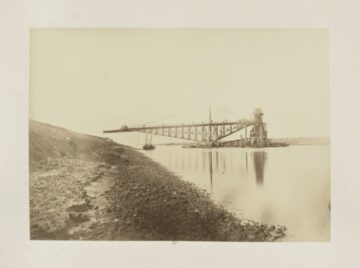Charmaine Chua in the Boston Review:
 Beginning in the late 1860s, the decade that it took to construct the Suez Canal, photographs depicting its feats of engineering circulated across the world. Sold to travelers as souvenirs, featured in Le Monde, and later exhibited at the 1889 Paris world fair, they enshrined on paper the industrial monumentality of the dredgers that excavated earth into sea.
Beginning in the late 1860s, the decade that it took to construct the Suez Canal, photographs depicting its feats of engineering circulated across the world. Sold to travelers as souvenirs, featured in Le Monde, and later exhibited at the 1889 Paris world fair, they enshrined on paper the industrial monumentality of the dredgers that excavated earth into sea.
As publicized images of the machinic wonders of modernity, they also served as promissory notes, enticing investors to purchase shares in the joint-stock Suez Canal Company. The photographs telegraphed seductive promises of financial gain, pictorializing the genius of European engineering that could dig a manmade channel across the African continent. Running through the pictures, historian Mohamed Gamal-Eldin discovered, was a striking pattern. For the technological sublime to work its wonder on the awed spectator, the photos had to be evacuated of the laboring subjects who made the feat possible: the many tens of thousands of dispossessed fellahin—peasants—who dug the monumental canal by hand.
More here.
